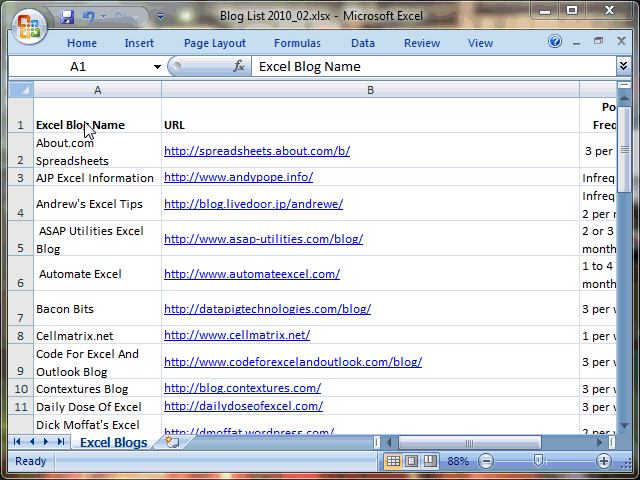Navigating large regions of data can be very quick and easy using keyboard or mouse shortcuts. You can also select entire rows or columns, although multiple row and column ranges work slightly different with each method.
Using the Keyboard to Navigate a Range of Data
I prefer to navigate ranges using the keyboard. Holding down the control key plus an arrow key (Ctrl+Arrow key) will do the trick, assuming there are no blank cells in the range. Technically, the last non-blank cell in the same column or row will be selected.
When inside a region of data you can move to the bottom of the range quickly by using the keyboard combination Crtl+Down Arrow. By including the Shift key with this combination (Ctrl+Shift+Down Arrow) the data between the active cell and the end of the range will be selected.
The other navigation keys — up, right and left — work in a similar manner while holding down the control key.
- Move to Right Side: Ctrl + Right Arrow
- Move to Left Side: Ctrl + Left Arrow
- Move to Top: Ctrl + Up Arrow
- Move to Bottom: Ctrl + Down Arrow
Using a Mouse to Navigate a Range of Data
Moving the mouse over an active cell changes the cursor to a thick white cross. In order to navigate to the bottom of a range, move the cursor to the bottom of the active cell, where the cursor will change to an arrow cross, and then double-click the cell border.
Double clicking the right side of the active cell border will take you to the right side of the range. Double-clicking the top of the active cell takes you to the top of the range, and double-clicking the left border of the active cell takes you to the left side of the range.
You can see this method in action in the picture below where the active cell moves from cell A1 to A47 to D47 to D1, and back again to A1.

Data can be selected when using the mouse by holding the Shift key down when the cell border is double-clicked. This is a nifty way to select an entire row or column of data within a range.
All of these methods of navigating and selecting data assume there are no blank cells in the rows or columns of the data range. Selecting data using the Ctrl+Shift+Arrow key is extending the selection from the active cell to the last non-blank cell in the same column or row.
Select Multiple Rows or Columns of Data in a Range
More than one row or column can be selected, but what data is selected depends on which method you use. For example, assume that blank cells are located only in column C, and cells A1 to C1 are currently selected.
By using the keyboard shortcut Ctrl+Shift+Down Arrow, the driving factor for data selction is the active cell: A1 or C1. If A1 is the active cell the entire range A1:C47 is selected. If C1 is the active cell, the range A1:C24 is selected because C25 is a blank cell.
In using the Mouse technique, assuming cells A1 to C1 are currently selected, the only determining factor to what data is selected is the cell that is double-clicked. The active cell does not matter. So if A1 is the active cell, but the lower border of cell C1 is double-clicked with the Shift key, the range A1:C24 is selected.
The video below goes through all of these different methods.

Don’t forget Ctrl+. (period), which cycles through the corners of a range. For example, if you select A1:J25, pressing Ctrl+. repeatedly will select A1, then J1, then J25, then A25.
Outstanding! Thanks for the tip. Obviously I didn’t know that one. Can’t wait to try it out.